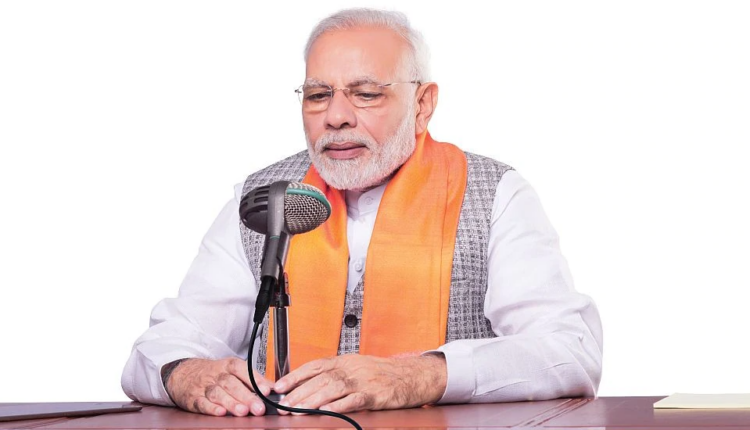Eminent people from various fields to witness the special screening organised by Ministry of I & B
As Prime Minister Narendra Modi’s monthly radio broadcast ‘Mann Ki Baat’ is completing its 100th episode, the Ministry of Information and Broadcasting is all set to organise live screening of the programme at all the Raj Bhavans of the country on 30th April, 2023. In line with this initiative, the Raj Bhavan at Guwahati is also gearing up for the live screening of the 100th episode of “Mann ki Baat”. Media Units in Guwahati under the Ministry of Information of Broadcasting in collaboration with the Raj Bhavan are organising the special screening of the popular radio programme.
The Governor of Assam, Shri Gulab Chand Kataria will grace the occasion as the Chief Guest. Eminent people in various fields and public representatives have been invited for the programme. Apart from this, people from the state whose work has been appreciated in the previous Mann Ki Baat programme, have also been invited to witness the special screening of the 100th episode of “Mann Ki Baat”.
The first episode of Prime Minister’s Mann Ki Baat was broadcast on 3rd October, 2014 (Friday) on the auspicious occasion of Vijayadashami through All India Radio (AIR). Since April 2015, Mann Ki Baat, the monthly radio programme is broadcast on the last Sunday of every month and the latest broadcast of 99th episode was on 26th March, 2023. Besides all networks of AIR it is visualized by Doordarshan and telecast on its entire network. It is also broadcast in sign language on Doordarshan. The 100th episode of Mann Ki Baat is scheduled on 30th April, 2023.
The first episode of Mann Ki Baat was of a duration of 14 minutes, which increased to 19 minutes in second episode and 26 minutes in third episode. Since 4th episode, the duration of each episode has remained 30 minutes.
Initially, the broadcast was in Hindi language only, and subsequently, the English version started from 31st January, 2016 and Sanskrit version from 28th May, 2017. Currently, Mann Ki Baat is broadcast in 23 languages including 22 Indian languages and English, 29 dialects (25 from North East and 4 from Chhattisgarh) and in 11 foreign languages. The Indian languages include Hindi, Sanskrit, Punjabi, Tamil, Telugu, Kannada, Marathi, Gujarati, Malayalam, Odia, Konkani, Nepali, Kashmiri, Dogri, Manipuri, Maithili, Bengali, Assamese, Bodo, Santhali, Urdu and Sindhi. The dialects are Chhattisgarhi, Gondi, Halbi, Sargujia, Pahari, Sheena, Gojri, Balti, Ladakhi, Karbi, Khasi, Jaintia, Garo, Nagamese, Hmar, Paite, Thadou, Kabui, Mao, Tangkhul, Nyishi, Adi, Monpa, Ao, Angami, Kokborok, Mizo, Lepcha and Sikkimese (Bhutia). French, Chinese, Indonesian, Tibetan, Burmese, Baluchi, Arabic, Pashtu, Persian, Dari and Swahili are the foreign languages in which the broadcast is done.
Prime Minister has mentioned over 700 Individuals and around 300 organizations so far in the Mann Ki Baat Program. These include 37 individuals and 10 Organizations from foreign countries as well.



cheap cialis online Not hopeless
248650 430840This really is sensible info! Exactly where else will if ind out more?? Who runs this joint too? sustain the good function 386378
184215 97423Do men and women nonetheless use these? Personally I adore gadgets but I do prefer something a bit much more up to date. Still, nicely written piece thanks. 806836
Vibracion del motor
Aparatos de equilibrado: esencial para el rendimiento fluido y productivo de las dispositivos.
En el entorno de la avances actual, donde la productividad y la confiabilidad del aparato son de alta trascendencia, los sistemas de ajuste juegan un rol fundamental. Estos dispositivos dedicados están creados para balancear y regular piezas dinámicas, ya sea en equipamiento de fábrica, medios de transporte de transporte o incluso en aparatos de uso diario.
Para los especialistas en soporte de aparatos y los especialistas, operar con dispositivos de ajuste es esencial para garantizar el funcionamiento estable y fiable de cualquier sistema rotativo. Gracias a estas opciones tecnológicas innovadoras, es posible minimizar sustancialmente las sacudidas, el estruendo y la carga sobre los rodamientos, extendiendo la vida útil de piezas valiosos.
De igual manera significativo es el tarea que tienen los aparatos de equilibrado en la servicio al usuario. El ayuda técnico y el soporte regular aplicando estos sistemas habilitan dar servicios de óptima excelencia, aumentando la bienestar de los consumidores.
Para los responsables de emprendimientos, la financiamiento en equipos de balanceo y detectores puede ser clave para aumentar la efectividad y productividad de sus dispositivos. Esto es especialmente importante para los inversores que dirigen modestas y medianas emprendimientos, donde cada aspecto importa.
Asimismo, los aparatos de equilibrado tienen una gran implementación en el sector de la protección y el supervisión de estándar. Facilitan localizar probables errores, reduciendo arreglos costosas y averías a los sistemas. Además, los resultados generados de estos equipos pueden usarse para mejorar procedimientos y mejorar la presencia en plataformas de investigación.
Las zonas de implementación de los sistemas de calibración comprenden múltiples industrias, desde la elaboración de bicicletas hasta el seguimiento ecológico. No influye si se trata de enormes elaboraciones de fábrica o limitados establecimientos caseros, los equipos de balanceo son necesarios para garantizar un funcionamiento productivo y sin interrupciones.